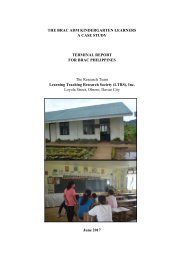terminal_report_final1
Create successful ePaper yourself
Turn your PDF publications into a flip-book with our unique Google optimized e-Paper software.
P a g e | 4<br />
• Resources available for all areas related to income of households (for the<br />
demand), accessibility to other resources like roads, transportation, etc.<br />
4) Provide financial projections to operate the school including start-up and<br />
annual operating budgets. It will include the growth plan of the BIS. It shall<br />
also highlight worst and best case scenarios.<br />
5) Offer recommendations and other findings intended to shape the project and<br />
enhance success. These may include key program milestones, time tables,<br />
benchmarks, and deadlines.<br />
II. Method<br />
This study followed the qualitative research design. To gather the data, it<br />
made used of survey questionnaire, key informant interview guide and document<br />
analysis. The survey questionnaire was used to assess the trajectory of the identified<br />
markets. This is necessary to find the point where supply and demand intersect to<br />
supply the right kind of education at the right price. A market analysis accumulates<br />
information on as many factors as possible to make an educated guess. This guess<br />
is based on four basic components: (1) the project description, (2) a demand<br />
assessment, (3) a review of supply, and (4) a synthesis. The first three steps review<br />
detailed market information and note the implications for the proposed project. The<br />
final stage draws conclusions from those implications (Novak, 1996).<br />
Considering that the study aimed to establish and enterprise school on<br />
quality basic education for children of low-income families, it observed the<br />
following procedures: first the researchers identified 4 sites based on determined<br />
criteria; second, it pegged the number of respondents per site to 50. The market was<br />
surveyed using the following characteristics: age, sex, civil status, estimated gross<br />
monthly income, highest educational attainment, and household size. Likewise, it<br />
profiled the markets’ willingness to pay for tuition and other school fees and the<br />
kind of education they would like to get in return.<br />
Key informant interview (KII) was also used. KIIs involve interviewing a<br />
select group of individuals who are likely to provide needed information, ideas, and<br />
insights on a particular subject. The informants are selected because they possessed<br />
information or ideas that would shed more light to the study (Kumar, 1989). In the<br />
present activity, two supervisors from the Department of Education (DepEd), and<br />
one owner of a private school in Davao City were interviewed. The interviews<br />
centered on the requirements set by DepEd to open a new private school, the<br />
challenges management has to take on, and whether or not DepEd can offer some<br />
help for the newly opened private schools.




